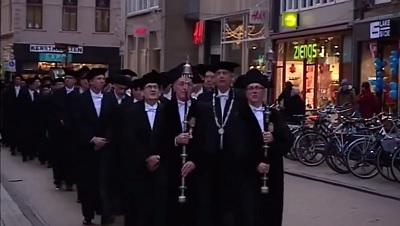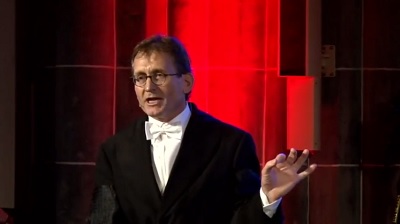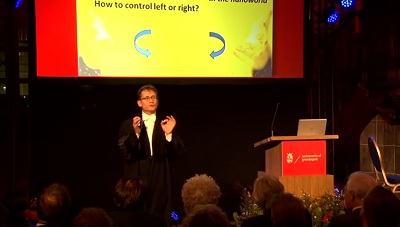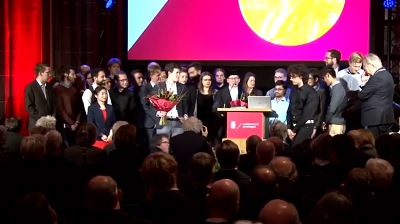Groningen throws Nobel party for Feringa
As the number of seats in Stockholm is limited to say the least, the University of Groningen organized its own Nobel lecture in the Martinikerk on 30 November. For Ben Feringa, the official academic ceremony with professors in gowns was the ideal dress rehearsal for the award ceremony on 10 December. The mood was relaxed, and the audience hung on Feringa’s every word.

In a packed Martinikerk, the audience watched the professors’ cortège arrive from the Academiegebouw. Two beadles led the long procession to the Grote Markt, where a giant version of Feringa’s nanocar built by the City of Groningen and the University of Groningen awaited. After a quick photo opportunity with the giant nanocar, the cortège continued on to the church.
Once the professors had taken their seats – which took some time because of the huge turnout – Rector Magnificus Elmer Sterken opened the official ceremony. Throughout the afternoon, he deftly struck a balance between formal academic ceremony and celebratory mood. The official announcement of the Nobel Prize for Chemistry 2016 was shown again on the screens, as was Feringa’s appointment as Commander in the Order of the Lion of the Netherlands. Then it was time for a musical interlude by Daniël Lohues – just like Feringa from the province of Drenthe.
Birds
Then Feringa took the stage. He spoke without notes, relying only on a small number of slides. Entitled ‘The Art of Building Small’, the lecture took the audience on a journey to the wonderful world of molecules. Feringa spoke about the differences between the natural nanomachines in our cells and the molecular motors that he and his colleagues build – and the now familiar comparison with the first flight by the Wright brothers.

What Feringa creates is inspired by, but at the same time very different from, nature. Just as aeroplanes are inspired by birds but fly in a very different way. And, Feringa emphasized, although we can build aeroplanes we are totally unable to construct a bird or even a cell of a bird.
Feringa then told the story of his research into motors, which began with a hunt for molecules that can store information, a collaboration with Philips. The idea was inspired by the molecules in the eye that absorb light and respond to it by changing shape. An artificial molecule that switches between two positions in response to light was the basis for the light-driven motor molecule.
In future, molecular motors might even drive small nanorobots that roam through the body. The main application at the moment is the creation of smart surfaces and of medication that is activated by light at the site where it is needed. Feringa is working on this with colleagues from the University Hospital UMCG.

Thanks
At the end of the lecture Feringa thanked his wife Betty and his secretary Tineke Kalter. His late parents earned a special mention because they encouraged him to continue with his studies at a time when higher education was not for the masses. His nine brothers and sisters were all at the ceremony. Feringa ended with the words ‘imagine the unimaginable’ and thunderous applause burst from the audience, which took some time to die down.
Daniël Lohues then played his song ‘op fietse’ [on your bike] and photos of a cycling Feringa filled the screens in the church. Lohues was followed by Mayor Peter den Oudsten, who announced that the city council had made Feringa an honorary citizen of Groningen: ‘We had to bend the rules a bit, because officially only the city’s inhabitants can become honorary citizens.’ Feringa lives in the neighbouring municipality of Tynaarlo.

Honorary Medal
Then it was time for the Mayor to show that he had been listening to Feringa. Ever since the announcement that he had won the Nobel Prize, Feringa has stressed that his work is only possible thanks to his good team. Den Oudsten awarded the Honorary Medal of the City of Groningen to the whole team. Although protocol required a single member of Feringa’s team to receive the medal, the whole group was soon invited up on to the stage, with Feringa beaming in their midst.
In the last part of the ceremony, Feringa was interviewed by Volkskrant journalist Martijn van Calmthout. His questions focused on how Feringa works and what it felt like to win the Prize. One remark stood out in particular: when talking about the ‘beauty of molecules’ Feringa admitted that scientists are not always governed by reason but sometimes just go with their instincts. He also told us about how when reading the newspaper he finds himself doodling new molecules in the margins.
Elmer Sterken closed the official part of the ceremony and invited the whole audience – not just those in gowns – to join him for drinks afterwards. A fitting end to this Drenthe-Groningen celebration. A pared-down, and undoubtedly more formal, version will take place on 10 December.
| Last modified: | 19 September 2017 12.05 p.m. |
More news
-
10 June 2024
Swarming around a skyscraper
Every two weeks, UG Makers puts the spotlight on a researcher who has created something tangible, ranging from homemade measuring equipment for academic research to small or larger products that can change our daily lives. That is how UG...
-
21 May 2024
Results of 2024 University elections
The votes have been counted and the results of the University elections are in!

